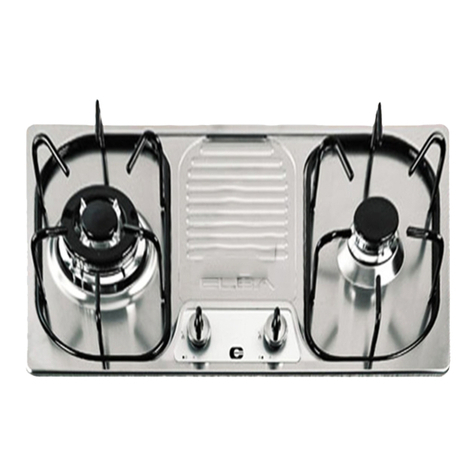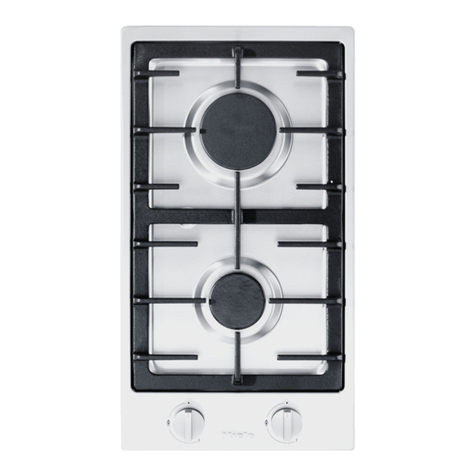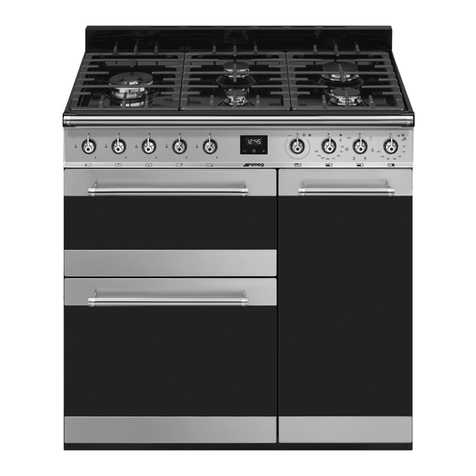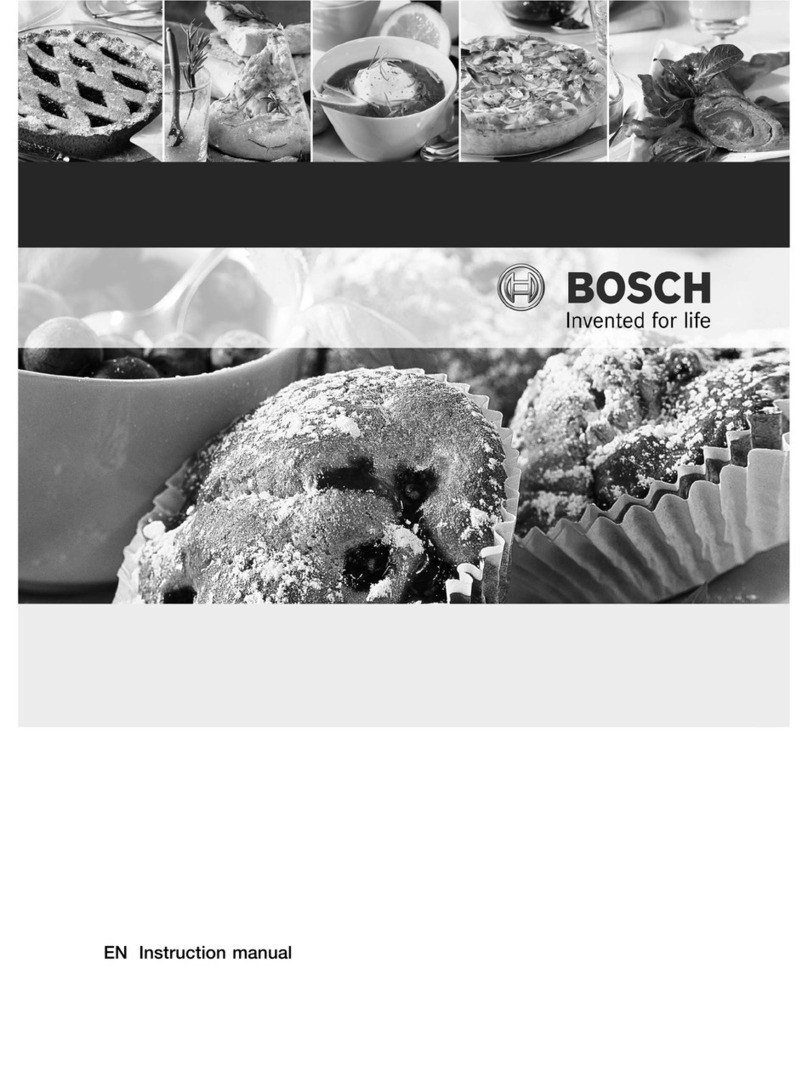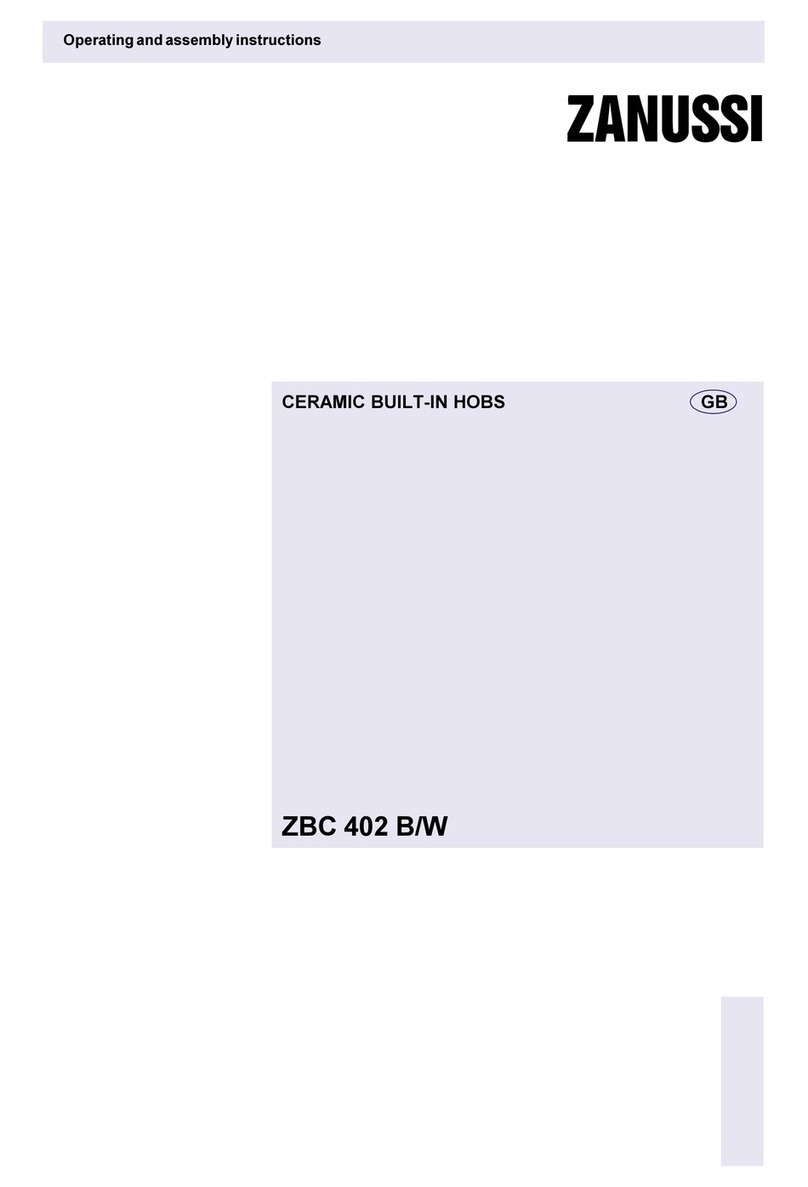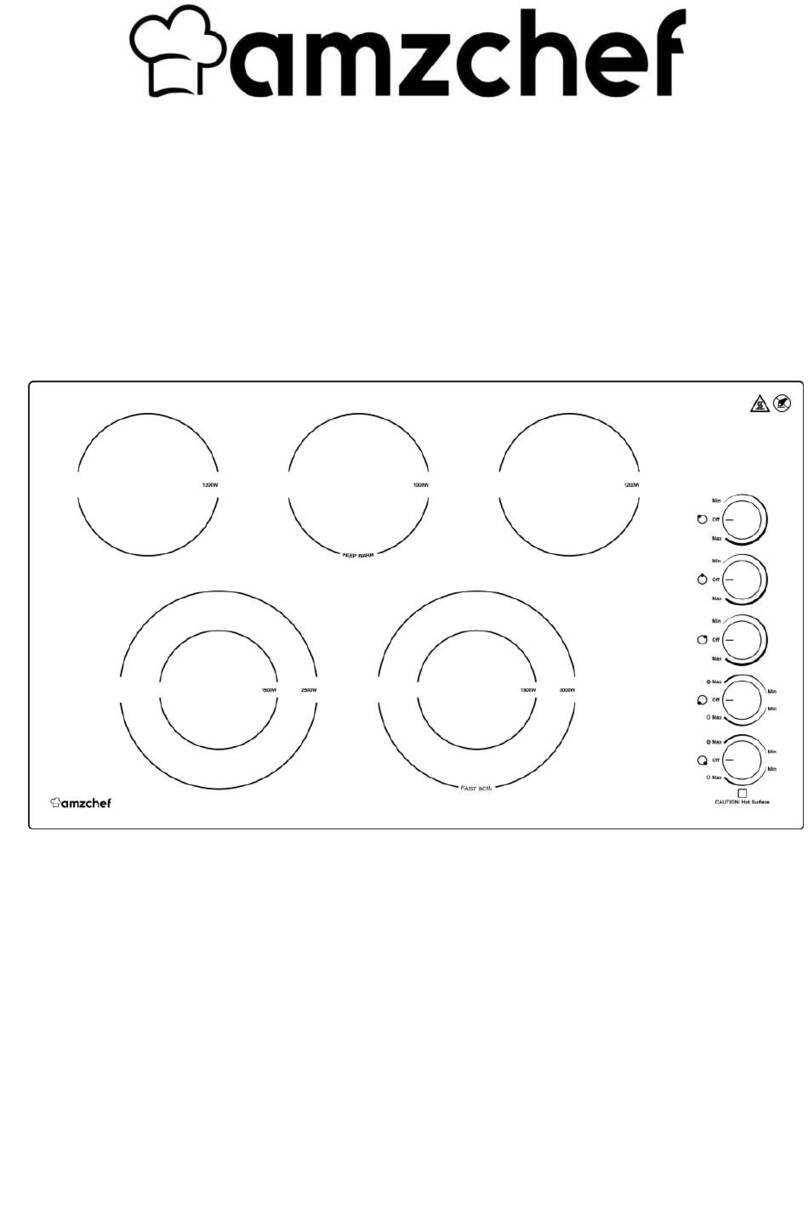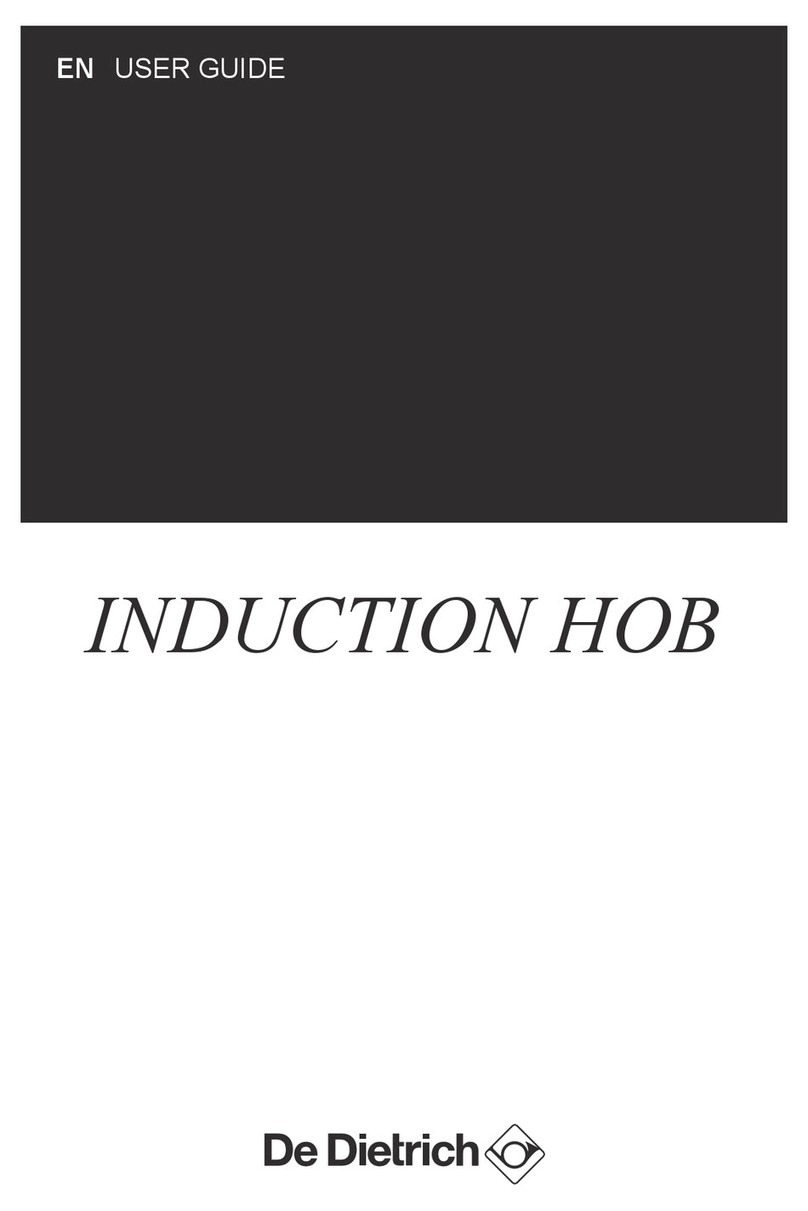Focal Point HB0420X4 Technical manual

Page 1 of 10
INSTRUCTIONS MANUAL AND HINTS FOR
THE USE, INSTALLATION AND MAINTENANCE
FOR BUILT-IN GAS HOBS
The appliance was designed and made in accordance with the European standards listed below:
⇒EN 30-1-1, EN 30-2-1 and EN 437 plus subsequent amendments (Gas Standards).
⇒EN 60 335-1 and EN 60 335-2-6 plus relative amendments (Electrical Standards).
The appliance complies with the prescriptions of the European Directives as below:
⇒73/23/EEC + 93/68/EEC concerning electrical safety (LVD).
⇒89/336/EEC + 92/31/EEC + 93/68/EEC concerning electromagnetic compatibility (EMC).
⇒90/396/EEC + 93/68/EEC concerning gas safety (GAD).
“These instructions are only valid if the country symbol appears on the Instruction Manual and on the appliance”

Issued on date: 06/04/2006 – Rev. Index: 00
Page 2 of 10
TECHNICAL ASSISTANCE AND SPARE PARTS
Before this appliance left the factory it was tested and set (see the specific adjustment sticker data plate, put on the bottom of the
appliance, to check gas adjustment) by specialized, expert personnel to guarantee the best functioning results.
Attention: Qualified personnel must do any subsequent repairs or adjustments that may be necessary with the maximum
care and attention.
For this reason we always recommend contacting the nearest Assistance Centre of ours, specifying the brand, model, serial number
and type of problem you are having with it. You will find the relative technical data printed on the nominal data sticker, put on the
bottom of the appliance and on the last but one page of this Instruction Manual.
With this information the technical assistant can come with the right spares parts and guarantee a prompt job.
You will find original parts and optional accessories at our Technical Assistance Centres and authorised dealers.
CONTENTS
1. IMPORTANT NOTES AND PRECAUTIONS FOR USE page no. 3
2. DESCRIPTION OF THE APPLIANCE page no. 4
3. INSTRUCTIONS FOR THE USER: USE
Presentation page no. 4
Notes on safety page no. 4
Gas burners page no. 5
4. INSTRUCTIONS FOR THE USER: CLEANING AND MAINTENANCE page no. 6
5. WHAT TO DO IF ..... page no. 6
6. INSTRUCTIONS FOR THE INSTALLER
Technical information page no. 6
Installing the hob page no. 6 and 7
Gas connection page no. 8
Electrical connection page no. 8
Adjustments page no. 9
Conversion page no. 9
Maintenance page no. 9
7. TECHNICAL FEATURES
Injectors table page no. 10
Electrical components page no. 10

Issued on date: 06/04/2006 – Rev. Index: 00
Page 3 of 10
1. IMPORTANT NOTES AND PRECAUTIONS FOR USE
You have purchased one of our products for which we thank you. We are confident that this new appliance, modern, functional and
practical, made with top quality materials, will meet all your demands.
This new appliance is easy to use but before installing and using it, it is important to read this Instruction Manual through
carefully. It provides information for a safe installation, use and maintenance. Keep this Instruction Manual in a safe place for future
reference.
The manufacturer reserves the right to make all the modifications to its products that it deems necessary or useful, also in your
interests, without prejudicing its essential functional and safety characteristics.
The manufacturer cannot be held responsible for any inaccuracies due to printing or transcription errors that may be found in this
handbook.
N.B.:
the pictures shown in the figures in this handbook are purely indicative.
•The installation, adjustments, conversions and maintenance jobs (part “6. INSTRUCTIONS FOR THE INSTALLER”) must be
carried out by qualified installers only.
•The installation of all-gas and combi appliances must comply with the National Standards in force.
•The appliance must only be used for what it has been made for: “Cooking for domestic use only!” Any other use is considered
improper and dangerous.
•The manufacturer cannot be held responsible for any harm to people or damage to things deriving from an incorrect installation or
maintenance or from an erroneous use of the appliance.
•Once the outer wrapping and the inner wrappings of the various parts have been removed, check and make sure that the
appliance is in perfect condition. If you have any doubts do not use the appliance and call in a qualified person.
•The packaging materials used (cardboard, bags, polystyrene foam, nails, etc.) must not be left anywhere in easy reach of children
because they are a potential hazard source. To safeguard the environment all packaging materials are environments friendly and
recyclable.
•The electrical safety of this appliance is only guaranteed if it is correctly connected to a good earth system, as prescribed by the
electrical safety standards. The manufacturer declines all responsibility if these instructions are not followed. Should you have any
doubts please consult a qualified gas and/or electrical installer.
•Prior to connecting the appliance ensure that the rating plate data correspond to those of the gas and electricity mains (see part
“7. TECHNICAL FEATURES”).
To use any kind of electrical appliance there are a few basic rules that must be observed:
⇒Do not touch the appliance if your hands or feet are wet or damp.
⇒Do not use the appliance bare footed.
⇒Do not pull the lead to take the plug out of the socket.
⇒Do not leave the appliance outside under the sun, rain, etc.
⇒Do not let children or anybody who is incapable to use the appliance on their own.
•If you are using a socket near the appliance make sure that the cables of electrical appliances you are using do not touch it and
are far enough away from all hot parts of the appliance.
•When you have finished using the appliance check that all the controls are in the off or closed position, checking that the “0” of the
knob corresponds to the “•” symbol screen printed on the front panel.
•Take the plug out of the socket before you start cleaning or servicing the appliance.
•In the case of a failure and/or malfunction, turn the hob off and take the plug out of the socket; do not tamper with it. Qualified
personnel must do all repairs or settings with maximum care and attention. For this reason we recommend you call the nearest
Assistance Centre of ours, explaining the trouble and giving the name of the model.
If an appliance is out of order or is not going to be used any more, it must be rendered useless by eliminating those parts that could be
a hazard source for children when they are playing, for example:
⇒The power cable.

Issued on date: 06/04/2006 – Rev. Index: 00
Page 4 of 10
2. DESCRIPTION OF THE APPLIANCE
1. Rapid gas burner (R) of 3,00 kW
2. Semi-Rapid gas burner (SR) of 1,75 kW
3. Auxiliary gas burner (Aux) of 1,00 kW
4. Ultra-Rapid triple crown (UR-3c) of 3,50 kW
5. Gas burner control knob
6. Pan support for 2 burners
1
2
5
6
3
4
Attention:
Pan supports are the same in shape; pay attention to put them in proper position, according to the burners’ diameter!
3. INSTRUCTIONS FOR THE USER: USE
PRESENTATION
The burners are graduated in their size and rating to provide the exact heat required for every style of cooking.
The burners can be equipped with Flame Safety Device (FSD = Thermocouple fig. 5 Tc).
On the top of each knob there is a printed diagram showing to which burner or heating element it refers.
GENERAL NOTES ON SAFETY
• When the burners or plates are in use do not leave them unattended and make sure there are no small children in the
vicinity. Check that pan handles are positioned correctly and always keep an eye on the pan whenever oils or fats are
used as they are easily inflammable.
• Do not use spray cans near the appliance when it is in use.
• If the built-in hob has a lid, before opening the lid remove any food deposits from its surface.
• If the built-in hob has a crystal glass lid, it can explode if heated. Turn in “Off” position all the burners (full disk symbol
on control panel) and switch off all plates; let the hob become cool before closing the lid.
• If you see any cracks on the surface of the plate, disconnect the appliance from the mains immediately.
• After you have used the appliance make sure that all the controls are in “Off” position (full disk symbol on control panel).

Issued on date: 06/04/2006 – Rev. Index: 00
Page 5 of 10
GAS BURNERS
Manual ignition
Press and turn anclockwise the knob corresponding to the burner you wish to use from “Off” position (full disk symbol on control
panel), until it reaches the “Maximum” position (fig. 1) corresponding to the big flame and place a lighted match close to the burner.
After ignition, turn the handle from “Maximum” position (corresponding to the big flame) to “Minimum” position (corresponding to the
little flame) and check stability flame. To turn “Off” the burner, turn clockwise the handle up to “Off” position (full disk symbol on control
panel).
= "Off" position (full disk).
= "Maximum" position (big flame).
= "Minimum" position (little flame).
Figure 1
FIG.1
Full on positio n
Reduc e rate p ositi on
Automatic electrical ignition (only certain versions, see fig. 5, ref. Ac)
The command of lighting is integrated in the control knob. Press and turn anclockwise the knob corresponding to the burner you wish
to use from “Off” position (full disk symbol on control panel), until it reaches the “Maximum” position (fig. 1) corresponding to the big
flame with little star. Automatically the ignition spark shoots; keep the knob pressed until flame ignition. Matches can be used to light
the burners in a blackout.
After ignition, turn the handle from “Maximum” position (corresponding to the big flame) to “Minimum” position (corresponding to the
little flame) and check stability flame. To turn “Off” the burner, turn clockwise the handle up to “Off” position (full disk symbol on control
panel).
Lighting of burners equipped with safety thermocouples (only certain versions, see fig. 5, ref. Tc)
In case burners are fitted with Flame Safety Device (FSD = Thermocouple fig. 5 Tc), repeat operations described previously. Once the
flame is alight, keep the knob pressed about for 10 seconds to allow the Flame Safety Device (FSD = Thermocouple) to warm up.
If, at the end of this time, the burner fails to alight, it means that Flame Safety Device (FSD = Thermocouple) is not sufficiently heated.
Repeat the operation.
Optimum use of the burners
To get the maximum yield with the minimum consumption of gas it is handy to keep the following points in mind:
• Once the burner has been alighted, adjust the flame according to your needs, from “Maximum” to “Minimum” position.
• Use proper pan size (with flat bottom only) for each burner (see the table below and fig. 2).
• When the content of the pan start to boil, turn the knob down to “Reduced rate position” (small flame).
• Always put a lid on the pan.
Burners Ultra-Rapid triple
crown 3,50 kW
Rapid
3,00 kW
Semi-Rapid
1,75 kW
Auxiliary
1,00 kW
Ø pans in cm
24-26 24-26 22-24 10-14
When a gas appliance is being used it produces heat and humidity in the room where it is installed. For this
reason the room must be well ventilated, keeping the natural ventilation openings free (fig. 6) and switching on
the mechanical aeration system (suction hood or electric fan - Figs. 7 and 8).
If the cooker is used for a long time additional aeration may be necessary, for instance, opening a window, or a
more effective aeration by increasing the power of the mechanical system if there is one.

Issued on date: 06/04/2006 – Rev. Index: 00
Page 6 of 10
4. INSTRUCTIONS FOR THE USER: CLEANING AND MAINTENANCE
Prior to any maintenance work or cleaning, disconnect the appliance from the electricity mains.
HOB
The surface of the hob, pan supports, enamelled burner caps (C) and burner heads (T) (see fig. 5) need to be cleaned after each time
they are used with warm soapy water, rinsed and then dried well to keep them in good condition.
Never clean when the top and components are still warm. Do not use metal or abrasive pads, abrasive powders or corrosive spray
products. Never leave vinegar, coffee, milk, salty water, lemon or tomato juice for any length of time on the surfaces.
WARNING:
Accessible parts may be hot, when the pan support is in use. Young children should be kept away.
Comply with the following instructions, before remounting the parts:
•Check that the heads burners and the relative burner caps, are correctly positioned in their housings (see fig. 5).
•Check that burner head slots have not become clogged by foreign bodies.
•Following installation or after a few times use, you find a tap is difficult to open or close do not force it but call for technical
assistance urgently.
•After use, to keep them in good condition, the plates (electric hob) should be treated with specific products, easily found in the
shops, to keep the surfaces clean and shining. This will also prevent rust from forming.
•If any liquid spills over it must always be removed with a sponge.
5. WHAT TO DO IF....
Some of the problems can be caused by simple maintenance operations or something that was forgotten and can be easily
resolved without having to call for technical assistance.
If your appliance is not working efficiently:
•Make sure the gas supply is open.
•Check the plug is in.
•Check that the knobs are set correctly for cooking and then repeat the operations given in the Instruction Manual.
•Check the electrical system safety switches (RCD). If there is failure in the system call an electrician.
6. INSTRUCTIONS FOR THE INSTALLER
TECHNICAL INFORMATION
•The installation, the adjustments, conversions and maintenance listed in this part must only be carried out by qualified installers.
The manufacturer cannot be held responsible for any damage to persons or things deriving from an incorrect installation of the
appliance.
•The safety and adjustment devices of the appliances may, during their life, only be modified by the manufacturer or duly
authorised installer or service engineer.
•All-gas appliances can be installed as “Class 3” (fitted) in compliance with gas Standards only.
•Any side walls (one only – left or right) that overcome in height the work top, need to be 300 mm from the edge of the hob.
•The installation of all-gas appliances must comply with the National Rules in force.
•This appliance is not connected to a flue for discharge of the combustion products; therefore, it must be connected in compliance
with the above mentioned installation rules. Particular attention must be paid to the instructions given below for ventilation and
aeration.
INSTALLATION
VENTILATING THE ROOMS
The room, in which the appliance is installed, must be permanently ventilated so as to guarantee correct functioning according to the
National Rules in force. The quantity of air needed is that required for a regular combustion of the gas and for the ventilation of the
room and whose volume must be no less than 20 m
3
. The natural flow of air must be direct through permanent openings in the walls
(that go through to the outside) of the room to be ventilated with a minimum cross free section of 100 cm
2
for appliance fitted with the
Flame Safety Device (FSD) on each burner (see fig. 6). These openings must be positioned so they cannot become obstructed.
If the appliance is not fitted with the Flame Safety Device (FSD) on each burner, the cross free section shall be not less than 200 cm
2
.
Indirect ventilation is also allowed by taking air from rooms adjacent to the one to be ventilated, strictly complying with the
prescriptions of the National Rules in force.
LOCATION AND AERATION
Gas appliances must always discharge the products of combustion through extractors connected to flues or directly to the outside (see
fig. 7). If it is impossible to use an extractor, a fan installed on the window or on a wall facing the outside is allowed and should be
switched on each time the appliance is used (see fig. 8), provided the rules and regulations in force relating to ventilation.

Issued on date: 06/04/2006 – Rev. Index: 00
Page 7 of 10
(*) Air inlet - minimum section 100 cm
2
UNPACKING THE APPLIANCE
Once the outer wrapping and the inner wrappings of the various parts have been removed, check and make sure that the appliance is
in perfect condition. If you have any doubts do not use the appliance and call your nearest Assistance Centre.
Some parts are mounted on the appliance and protected by a plastic film. This protective film must be removed before ever the
appliance is used. We recommend slitting the plastic film along the edges with a sharp knife or pin.
The packaging materials used (cardboard, bags, polystyrene foam, nails …) should not be left anywhere within easy reach of
children as they are a potential hazard source.
INSTALLING AND FIXING THE HOB
The measurements of the cavity made in the top of the modular cabinet and into which the hob will be recessed are indicated in fig. 9.
Cupboards or hoods have to maintain a least distance of 750 mm from the top.
IMPORTANT!
Under the hob it is necessary to always apply a panel of separation in wood, positioned to a least distance of 70 mm by the
bottom of the same, which has to easily be removable to allow possible operations of maintenance (see fig. 10).
The hob has a special seal which prevents liquid from infiltrating into the cabinet. Strictly comply with the following instructions in order
to correctly apply this seal:.
- Evenly and securely fix the seal to the hob, pressing it in place with the fingers.
- Remove the strip of protective paper from the seal. Insert the hooks into their relative housings (K) on the hob and set this into the
hole in the cabinet. Lock it in place with the relative fixing screws (V) (see fig. 12).

Issued on date: 06/04/2006 – Rev. Index: 00
Page 8 of 10
GAS CONNECTION
Before to connect the appliance to the gas network, check that the adjustment sticker data plate, put on the bottom of the
appliance, correspond to the available one in the gas network.
The adjustment sticker data plate, gives all the appliance’s setting conditions as: gas type and gas operating pressures.
Once installed, check there are no leaks using a soapy solution only. Never use a flame! It is forbidden!
The appliance’s gas inlet fitting is a G ½” male threaded cylindrical gas type in accordance with the Standard ISO 228-1.
When gas is distributed through ducts the appliance must be connected to the gas mains with:
⇒A flexible stainless steel, seamless pipe in accordance with the National Rules in force, with a maximum 2 metres extension and
seals in accordance with the National Rules in force. N.B.: Make sure that the pipe, once the appliance is installed, does not come
into contact with the mobile parts of the unit in which the hob is built-in (like drawers for instance), get squashed or is too bent.
⇒A rigid steel pipe in accordance with the National Rules in force, whose joints must be made using threaded fittings in accordance
with the Standard ISO 7/1. The use of hemp with suitable adhesives or Teflon tape as a sealant is not allowed.
⇒
A copper pipe in accordance with the National Rules in force, whose joints must be made using sealed fittings in accordance with
the
National Rules in force
.
When gas is supplied directly from a gas cylinder, the appliance, supplied by a pressure regulator in accordance with the Standard
EN 12864, must be connected:
⇒With flexible stainless steel, seamless pipes in accordance with the National Rules in force with a maximum 2 metres extension
and seals in accordance with National Rules in force. N.B.: Make sure that the pipe does not come into contact with the mobile
parts of the unit in which the hob is built-in (like drawers for instance), get squashed or is too bent. We recommend attaching the
special adapter to the flexible pipe, easily found on the market, to facilitate connection to the pressure regulator’s hose fitting on
the cylinder.
The pipe connecting the appliance with the gas mains should lie with smooth bends, and the rubber gasket preventing leakage added
by the installer between the appliance’s gas inlet fitting. Also the pipe connection must comply with the Standard EN 549 (obtained
from Technical Assistance Centres or authorised dealers).
CAUTION!
Carry out the connection avoiding all kinds of stress to the appliance.
ELECTRICAL CONNECTION
The electrical connection must be carried out in accordance with the current standards and laws in force.
Prior to connecting check that:
•The system and electrical sockets amperage is adequate for the appliance’s maximum power (see data label affixed on the bottom
of the appliance).
•The socket or system has an effective earth connection in accordance with current standards and with the law. All responsibility is
disclaimed if this is not complied with.
When connecting to the mains with a socket:
• Fit to the power cable (C) (if without – fig. 13) a standardized plug, suitable for the load which is indicated on the data label.
Connect the wires making sure they correspond as shown below, and remember that the earth wire must be always longer than
wires L and N (fig. 14):
Letter L (phase) = brown wire.
Letter N (neutral) = blue wire.
Symbol (earth) = green/yellow wire.
•The power cable must be laid so that no parts of it ever reach an over temperature of 75 K.
•For connecting do not use reductions, adapters or shunts as they could cause false contacts resulting in hazardous overheating.
•The appliance must be positioned so the plug is accessible.
When connecting directly to the mains:
-
Install a multipolar switch that can withstand the appliance load, with a minimum opening between the contacts of 3 mm, not less!

Issued on date: 06/04/2006 – Rev. Index: 00
Page 9 of 10
-
Remember that the earth wire must not be cut out by the switch.
-
As an alternative, the electrical connection can also be protected with a high sensitivity RCD.
ADJUSTING
•Check the adjustment of the appliance. Before making any adjustment to its operation, ensure proper adjustment to the
sticker data plate, on the bottom of the appliance.
•Before any adjustment is attempted, which may be necessary when installing for the first time or when converting gas
type, take the plug out of the mains socket.
•When the adjustment or preadjustment has been made, a technician must do any re-sealing, if any.
•To adjust “reduce rate”, using proper screw driver, from Natural gas to Butane/Propane ones, light burners one by one
and put handle in minimum position; remove the handle and screw clockwise completely the by-pass screw. Put back in
position the handle and check stability flame, turning the handle from “Maximum” to “Minimum” position and vice-versa.
•To adjust “reduce rate”, using proper screw driver, from Butane/Propane gases to Natural one, light burners one by one
and put handle in minimum position; remove the handle and unscrew anclockwise in the way to get proper flame. Put
back in position the handle and check stability flame, turning the handle from “Maximum” to “Minimum” position and
vice-versa.
•“Primary air adjustment” on hob gas burners is unnecessary.
TAPS
The adjustment of the reduced rate position is as follows:
• Light the burner and turn the knob to reduced rate position (small flame).
• Remove the knob which is simply inserted onto tap stem.
• Insert a small screwdriver into the top shaft and turn the throttling screw left or right until flame of the burner is conveniently
regulated to the low position.
• In the case of taps with safety thermocouples, the adjustment screw is on the side of the stem.
• Make sure that when turning quickly from “Maximum” position to “Minimum” one, the burner does not extinguish.
Attention: if the tap, after long use of the hob, present some friction to rotation, do not use it. Call the nearest
Assistance
Centre of ours that will take action to substitute the tap with the proper one.
CONVERSION
CHANGING THE INJECTORS
The burners can be adapted to different types of gas by simply installing the injectors suitable for the gas you want to use. The “kit
injectors” can be fitted with the appliance or available in an authorised Assistance Centre.
To do this, first remove the burner cups and with a socket spanner, unscrew injectors using proper tool and replace them with injectors
corresponding to the new adjustment gas type. Always tightly lock the injector in place, without adding any material on the injectors
threads: It is forbidden!
To help the installer there is a table on page 10 giving nominal heat inputs, injector diameter and operating pressures of the different
gas types. For best comprehension, each injector is marked on its body with proper diameter.
After the injectors have been changed, the technician must adjust the burners as described in the previous paragraphs, seal
any adjustment or preadjustment parts.
Important: after the conversion, substitute the adjustment sticker data plate put on the bottom of the appliance with the new
one, corresponding to the new gas adjustment. The sticker is included in the “kit injectors”.
MAINTENANCE
Prior to any maintenance work or before changing parts, disconnect the appliance from the gas and electricity power
sources.
REPLACING COMPONENTS
•To access the terminal board and the power cable, it is necessary to remove the hob from the cabinet by unscrewing the relative
fixing screws (V) (see fig. 12).
•If the power cable needs changing, call an authorised Assistance Centre as it is necessary the use of special tools. The
technician will have to connect a cable with a suitable cross section (see the table on page 13) keeping the earth wire
longer than the phase wires. In addition, follow the instructions giving in the “ELECTRICAL CONNECTION” paragraph.
•To replace other gas and electrical components, that are positioned inside the hob, it is necessary to remove the hob top
unscrewing the fixing screws of the burners
•Replace the seal each time you change a tap in order to guarantee a perfect tightness between body and rail.

Issued on date: 06/04/2006 – Rev. Index: 00
Page 10 of 10
7. TECHNICAL FEATURES
BURNERS INJECTORS AND HEAT INPUTS TABLE
(for the hob burners lay-out, see on page 4)
Burners
Gases and pressures Rates Injectors
diameter
Heat Inputs
(kW) By-pass
no
Denomination mbar g/h L/h 1/100 mm Min. Max 1/100 mm
1 Rapid (R)
G30 (Butane)
at 28-30 mbar
G31 (Propane)
at 37 mbar
G20 (Natural)
at 20 mbar
218
214
286
85
85
115-Y
0,75
0,75
0,75
3
3
3
42
Adjustable
2 Semi-Rapid (SR)
G30 (Butane)
at 28-30 mbar
G31 (Propane)
at 37 mbar
G20 (Natural)
at 20 mbar
127
125
167
65
65
97-Z
0,55
0,55
0,55
1,75
1,75
1,75
34
Adjustable
3 Auxiliary (Aux)
G30 (Butane)
at 28-30 mbar
G31 (Propane)
at 37 mbar
G20 (Natural)
at 20 mbar
73
71
95
50
50
72-X
0,35
0,35
0,35
1
1
1
27
Adjustable
4
Ultra-Rapid Triple
crown (UR-3c)
G30 (Butane)
at 28-30 mbar
G31 (Propane)
at 37 mbar
G20 (Natural)
at 20 mbar
255
250
333
95
95
130-K
1,6
1,6
1,6
3,5
3,5
3,5
68
Adjustable
Attention: Burners and injectors are made by SABAF.
ELECTRICAL COMPONENTS
Description Diameter in mm Nominal data
Supply cable 3 x 0.75 mm
2
3 x 0.75 mm
2
H05RR-F
H05VV-F
ATTENTION:
Apply here a copy of the data plate putted on the appliance
Table of contents
Popular Hob manuals by other brands

Electrolux
Electrolux EHG 679 B Instruction booklet

Beko
Beko HII63402MT installation instructions

VESTEL
VESTEL VEA24016 Operating and installation instructions
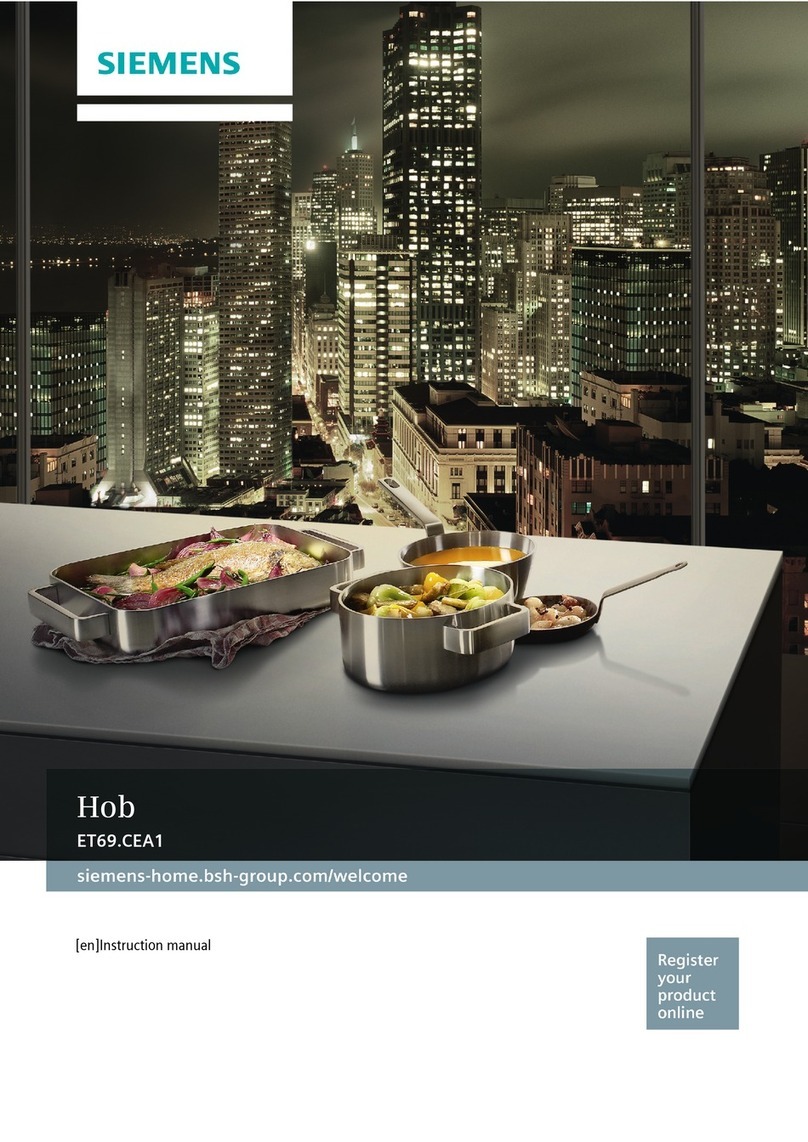
Siemens
Siemens ET69 CEA1 Series instruction manual

Whirlpool
Whirlpool BUILT-IN GAS HOB instructions

Gunter & Hauer
Gunter & Hauer CER 320 user manual
